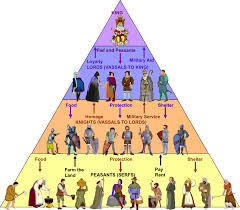Feudalism, a hierarchical system of land ownership and duties, emerged as a defining feature of medieval Europe. Rooted in the chaos following the fall of the Roman Empire, feudalism became the backbone of European societies for centuries. But what exactly was feudalism, and how did it shape the lives of those who lived under its rule? Let’s delve into the fascinating rise of this system of power and obligation.

The Seeds of Feudalism
The Fall of the Roman Empire
When the Western Roman Empire fell in 476 CE, Europe was plunged into a period of instability and fragmentation. Without the centralized authority of Rome, local leaders had to find ways to protect their territories and people from invasions by groups like the Vikings, Magyars, and Saracens.
The Need for Protection
In a world without standing armies or strong governments, security became the primary concern. Landowners, or lords, began granting parcels of land known as fiefs to warriors in exchange for military service. This laid the groundwork for the feudal system.
Check: Blast from the Past: The Technologies That Time Forgot
Understanding Feudalism
What Is Feudalism?
At its core, feudalism was a system of reciprocal relationships. Lords owned land and provided protection, while vassals, in return, offered military service, loyalty, and resources.
The Role of Land in Feudalism
Land was the currency of power. Unlike money, which was scarce during the Middle Ages, land provided food, resources, and status. Owning land was synonymous with wielding authority.
The Three Estates
Feudal society was divided into three main groups:
- The Clergy: Those who prayed and provided spiritual guidance.
- The Nobility: Warriors and landowners who governed and fought.
- The Peasants: Farmers and laborers who sustained society through their work.
The Hierarchical Structure
The King at the Top
The king was theoretically the supreme ruler, granting large estates to powerful nobles in exchange for their loyalty and military support.
Lords and Barons
Beneath the king were the lords and barons, who controlled vast swaths of land. They governed local regions and served as the king’s vassals.
Knights: The Backbone of Feudalism
Knights were professional warriors who pledged their allegiance to lords. In return for their service, they received smaller plots of land, known as manors.
The Peasantry
At the bottom of the hierarchy were the peasants, including serfs. While free peasants had some rights, serfs were bound to the land, unable to leave without their lord’s permission.
Life Under Feudalism
The Daily Lives of Peasants
Peasants’ lives revolved around agriculture. They worked long hours in the fields, grew crops, and raised livestock. In return, they received protection and a small share of the harvest.
Feudal Obligations
Feudalism was a system of mutual obligations. Peasants provided labor and a portion of their produce, while lords offered protection and the use of land.
The Manor System
Manors were self-sufficient communities. They included fields, pastures, a church, and the lord’s manor house. This system ensured stability and reduced reliance on external trade.
The Role of the Church
Spiritual Authority
The Catholic Church was a cornerstone of medieval life. It provided moral guidance and education, often justifying the feudal hierarchy as part of divine will.
Monasteries and Knowledge
Monasteries preserved knowledge through the Dark Ages, copying manuscripts and maintaining libraries. They also played a role in the local economy, owning lands and employing laborers.
Feudalism Beyond Europe
Feudal-Like Systems in Asia
While feudalism is most associated with Europe, similar systems existed elsewhere. In Japan, the samurai served daimyos in exchange for land, mirroring the lord-vassal relationship.
Variations in Feudalism
The specific rules and customs of feudalism varied by region. For instance, English feudalism was shaped by Norman influences, while French feudalism had its own unique features.
The Decline of Feudalism
The Rise of Centralized Monarchies
As kings consolidated power, they established standing armies, reducing the need for vassalage. This weakened the feudal system.
The Black Death’s Impact
The Black Death of the 14th century decimated Europe’s population, leading to labor shortages. Serfs gained leverage, demanding better conditions and wages.
The Growth of Trade and Towns
The expansion of trade and the rise of towns created new economic opportunities outside the feudal structure. Merchants and artisans formed a burgeoning middle class, challenging the old order.
Legacy of Feudalism
Feudalism’s Lasting Influence
Though feudalism faded, its impact lingered. The concepts of loyalty, duty, and hierarchical governance persisted in later political systems.
Romanticizing the Middle Ages
In literature and art, feudalism is often romanticized, with knights in shining armor and idyllic manors. However, the reality was far more complex and, at times, harsh.
Conclusion
Feudalism was a system born out of necessity, providing structure and security during a tumultuous period in history. While its rigid hierarchy and obligations may seem archaic today, feudalism laid the foundation for modern governance and social structures. Understanding its rise and fall helps us appreciate the intricate tapestry of human history.
FAQs
- 1. What is feudalism in simple terms?
- Feudalism is a system where landowners granted land to vassals in exchange for loyalty, military service, or labor, creating a structured society.
2. Why did feudalism develop?
Feudalism developed to provide security and order after the fall of the Roman Empire, especially during a time of frequent invasions.
3. How did the Black Death affect feudalism?
The Black Death caused labor shortages, empowering peasants to demand better conditions and weakening the feudal system.
4. Was feudalism unique to Europe?
No, similar systems existed in other parts of the world, like Japan’s samurai-daimyo relationship.
5. What ended feudalism?
The rise of centralized monarchies, standing armies, economic changes, and events like the Black Death contributed to the decline of feudalism.


